Review: #45026 Tubes (LEGO Education)
Want to expand the fun and learning potential of DUPLO with balls and tubes? Let’s see how easy it is to get things rolling…
This article was a joint effort of Amy & Tom Alphin. Amy provided the educator’s perspective and Tom focused on the technical aspects of the system.
DUPLO tubes were introduced back in 2002, but they have only been available in about a dozen sets, mostly in the LEGO Education line. (The straight sections of tube have been exclusive to LEGO Education products since 2008.) #45026 Tubes is the only currently available source for DUPLO tubes and balls (other than secondary markets).
Due to global disruption caused by COVID-19, LEGO Education sets are available for anyone to purchase at this time. That’s why we’re looking at the set from the perspective of both Teachers and Parents, in addition to young learners.
At the time of this publication, #45026 Tubes (LEGO Education) is available at LEGO.com for $139.95 (149.99€ / £134.99) The set includes 150 pieces, and 11 instruction cards (6 project cards and 5 multilingual “getting started” cards in 9 languages). This works out to around $1 per part, which seems awfully high, even for DUPLO. However, it’s worth noting that most colors of DUPLO Tubes cost $5 per straight section, and $3 per curved section on BrickLink, though used parts in certain colors are significantly less.
Parts
Let’s be honest, you aren’t buying this set for readily available DUPLO bricks and plates; it’s all about the tubes (and balls). That’s why I’ve put a quick analysis of the DUPLO Tubes system of parts at the top of this article!
The DUPLO tubes system consists of just six parts. This set includes:
- 18x – Straight Ball Tube (part 31452)
in 23Bright BlueBlue, 106Bright OrangeOrange, and 24Bright YellowYellow. - 18x – 45° Curved Ball Tube (part 31195)
in 322Bright PurpleDark Pink, 322Medium AzurMedium Azure, and 21Bright RedRed. - 3x – Vertical Ball Tube Holder (part 42029)
in 21Bright RedRed. - 6x – Horizontal Ball Tube Holder / Doorway (part 31191)
in 21Bright RedRed, and 24Bright YellowYellow. - 6x – Ball Tube Round Exit Door (part 31193)
in 21Bright RedRed, and 23Bright BlueBlue. - 6x – DUPLO Ball (part 41250)
in 21Bright RedRed, 23Bright BlueBlue, and 24Bright YellowYellow.
Parts are evenly distributed when multiple colors are listed above.
I do not want to waste your time, so I’m going to put it simply; the DUPLO tubes system is deeply flawed! The tubes are gendered, so they can only attach in one direction. They are difficult to connect because they require the two ends to be perfectly parallel to one another to snap together correctly. It’s even harder to connect tubes to the vertical and horizontal tube holders, and even once you do get them connected, the connections are flimsy and come loose easily.
Lastly, the part geometry is pretty weird, making it difficult to incorporate into your child’s ultimate DUPLO castle and ball pit. (Or whatever creation that your collective imagination dreams up.)
Part Geometry
DUPLO inherits the same awkward proportions as LEGO since they are exactly twice as big in all three dimensions. This includes the awkward 5-to-6 ratio of a LEGO brick’s width versus height. I’m sure this made it challenging for the part designers to identify the best length for straight sections and radius for the curved ones.
As you can see in this image, each tube section is three DUPLO studs long. The radius (based on the midpoint of the tube) is 2½ DUPLO bricks tall, which allows a 180° angle when stacking two Horizontal Ball Tube Holder / Doorway (part 31191).

An awkward spiral is possible by stacking the Horizontal Ball Tube Holder / Doorway (part 31191) at 90° angle.
I was quite surprised to see that you cannot use a vertical and horizontal tube holder to reinforce a 90° turn. Instead, you need to add a straight section of tube after the turn, then you can use the vertical tube holder. This is quite sturdy but bulky, and hard for kids to figure out on their own.
Likewise, as you can see in the photo, you need a DUPLO plate as a spacer if you want to use two vertical brackets in a row.
Resources for Teachers and Parents
One of the unique aspects of products in the LEGO Education line is that they include curriculum materials for Teachers. Sets like Spike Prime which are aimed at much older students include extensive online resources as well as apps for students to program their LEGO Robots.
In the case of sets like this which are aimed at much younger students, the primary instructional materials come in the form of glossy cardstock “Inspiration Cards”. There’s also a “Getting Started” sheet which encourages teachers to find more resources at LEGOeducation.com, although I was disappointed to find no additional resources on that page (besides the “Getting Started” guide in a few more languages).

Six “Inspiration Cards” teach you how to build a worm, chicken, monkey, dragon, kangaroo, and elephant.
Teacher’s Perspective:
The “Getting Started” cards are visually clean and easy to read and understand. The suggested aged range seems appropriate, though obviously younger builders would need more assistance than older students. That said, I think that the group size of 2-6 children seems a bit ambitious, especialy since the projects do not need more than one student to complete. A group of 1-4 students would be more realistic especially when students are just learning the system, and would reduce competition for a limited selection of pieces.
I appreciated that both the Project Ideas and the Learning Objectives are written in “age order”. That is to say that the first projects and learning objectives listed are aimed at the youngest builders, and the increase in complexity corresponds with an increase in age. I would have liked to see both the Common Core State Standards and the Next Generation Science Standards listed on the English teaching cards, as teachers are frequently asked to provide this information when they are creating lesson and unit plans, and writing grants to fund classroom projects. (A teacher could do this for him or herself, but it would have been a nice touch to include.)
The biggest question I have when looking at this product is, “what classroom or curricular problem is it solving?”. While the tubes have some vague curricular connections, they are mostly a fun addition to the DUPLO product line. This is not a bad thing at all, but I think it would be best used in a LEGO/DUPLO specific club or after-school group than in a general education classroom.
Parent’s Perspective:
This product is best used in a guided learning setting rather than hoping for your child to build a giant marble maze without your help. That’s why it may make sense in a homeschooling setting where you want to keep older kids engaged with DUPLO a little longer rather than migrating them to LEGO products. (This would be especially relevant if you have kids of different ages learning and playing in the same space.)
Should you decide to use this product in an unguided play setting despite these concerns, there are a few things to consider…
- It really is better suited for older builders who may be able to learn how to make these awkward connections on their own.
- You may have better results if you build one of the rigid tube assemblies outlined in this article in advance, and encourage your child to build a scene or building around the ball feature.
- You may want to keep the tubes and balls in a separate bin so you can remove them from your child’s play area when they get frustrated.
Conclusion
I love the idea of expanding options within the DUPLO line to make it more engaging for older builders. In a club-like setting or home, slightly older builders (in the 5-6 year old range) would have time to learn how the tubes work as a standalone product, and how to integrate them with their existing DUPLO collection. Which allows them to expand their parts knowledge, and get them thinking about building things beyond rectangular prism shapes.
Unfortunately, I think they missed the mark with this one—DUPLO Tubes are too difficult to assemble and are gendered. (Please tell me how I’m supposed to explain “male” and “female” parts to a five year old without leading to awkward questions.) Even as an adult builder, the tubes detached frequently when building even simple projects. There are some techniques which you can employ to get a more secure connection, but you should’t have to—It should be easy to connect and fairly secure. It’s not reasonable to expect kids to use a mix of DUPLO plates and bricks to securely attach vertical sections, but with 18 straight sections and 18 curved sections, kids are going to want to build a really long tube.
Instead of adding more complex components to DUPLO, I would love to see an LEGO Education product that includes both DUPLO and LEGO Bricks, showing young builders how the systems can work together to add detail to DUPLO creations. This would let young builders feel like they’re building with “real” LEGO Bricks, even if they are not quite ready for the complete selection of LEGO elements.
That’s why all of our tubes are now stored in a separate bin from our regular DUPLO pieces. It will remain an occasional parent-guided activity, but isn’t practical for child-led building. Between the relatively high cost (especially compared to this DUPLO-compatible marble maze that’s just 35$), this product does not make much sense in most homes. The set is not recommended for unguided play in the home.
Granted, this is less of an issue in a classroom where four kids could easily build simple tube creations inspired by the six Inspiration Cards. Many kids in the target ages of 3-6 years will be able to connect a few tubes to a single horizontal or vertical holder, and experience the fun of watching a ball roll through the tube. I can’t say for sure, but I think a single instructor or instructional assistant could help four kids create these simple tube creatures at the same time. That’s why the set earns a slightly better 2/5 star (Acceptable) rating for use in the classroom, or in more structured home learning scenarios.

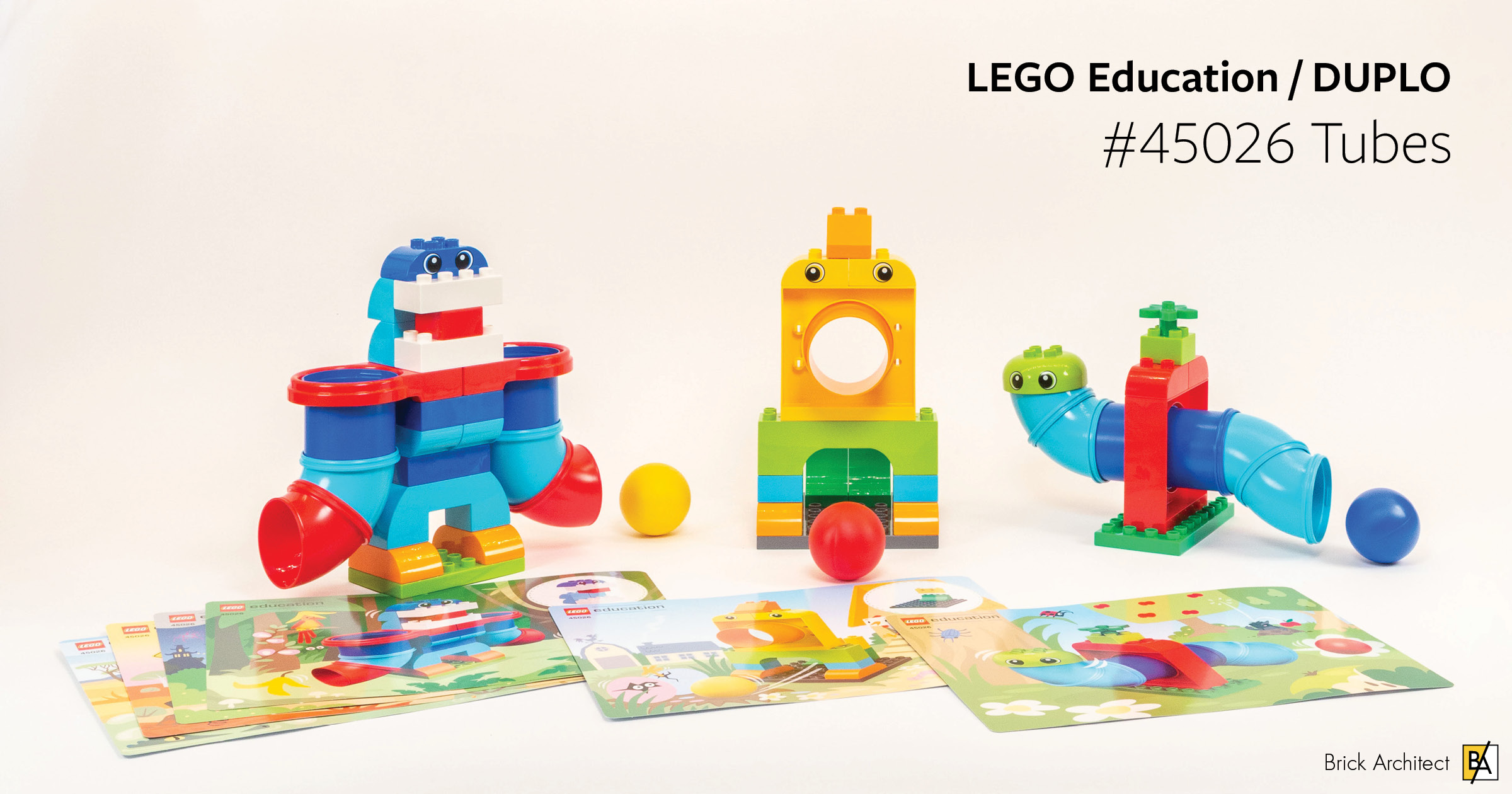
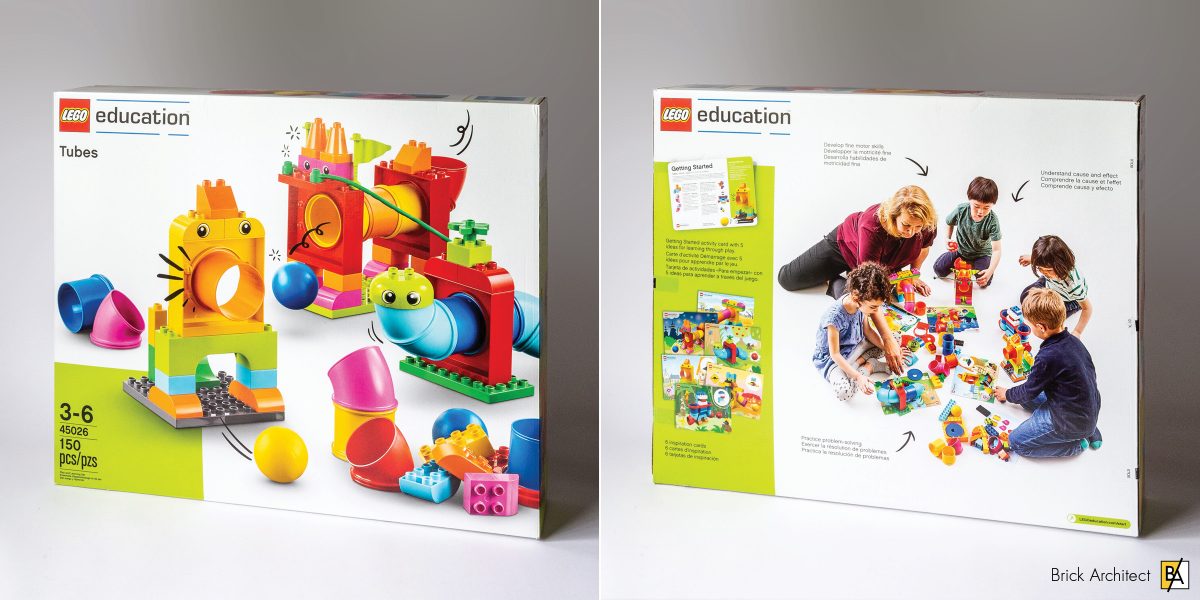
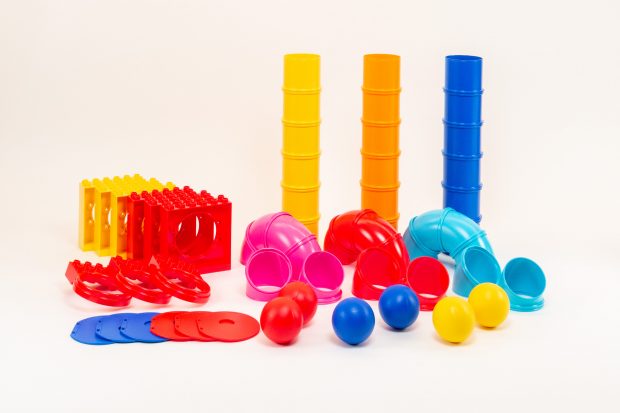


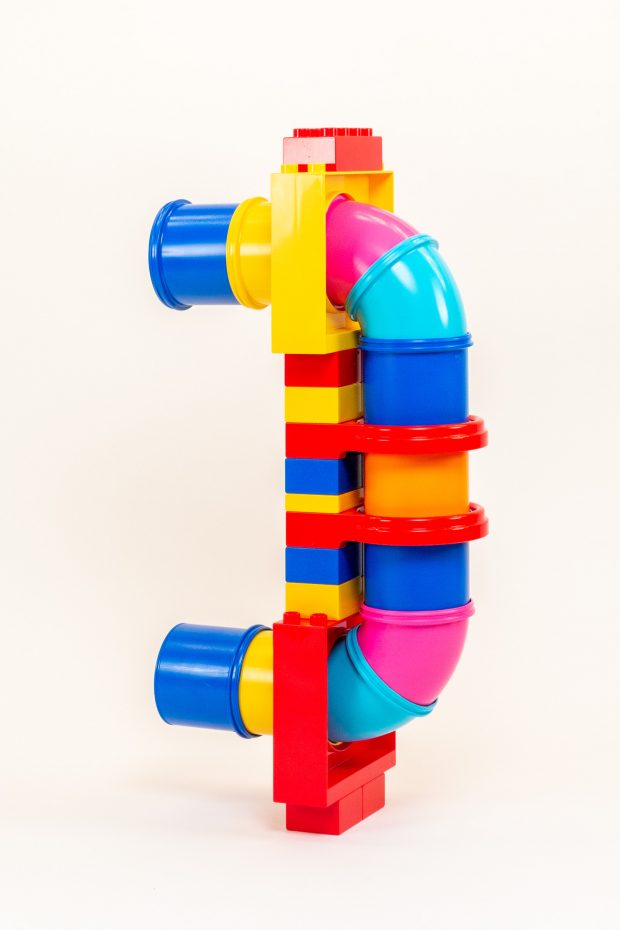
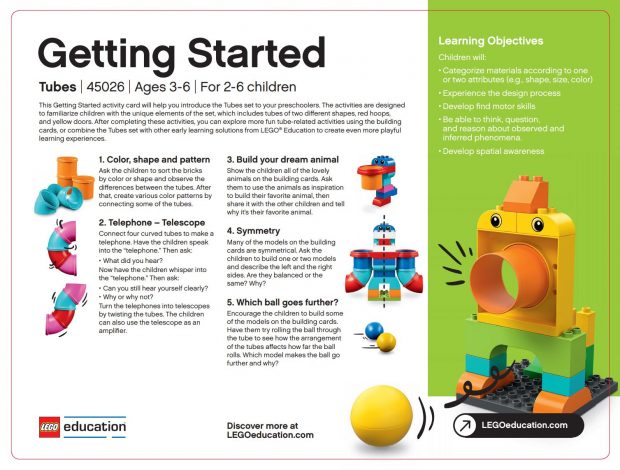
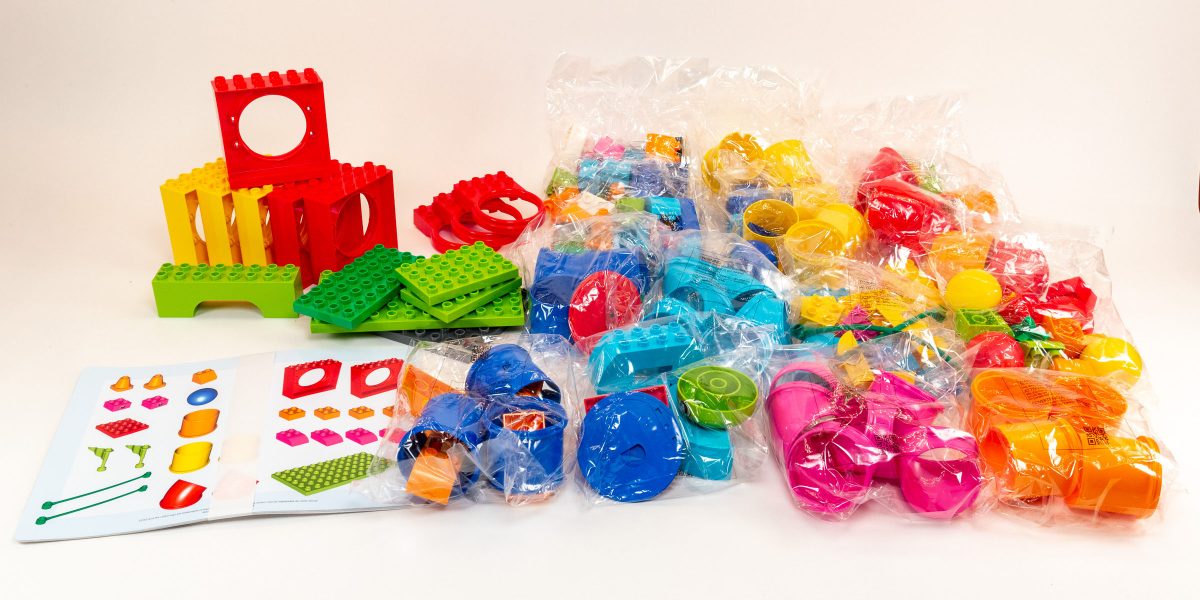
There’s a German compatible set of marble runs – Hubelino – and they’re nice but the edges of the pieces are very sharp. You’ve never stepped on LEGO until you’ve come foot first down on a Hubelino ramp. Pain incarnate.